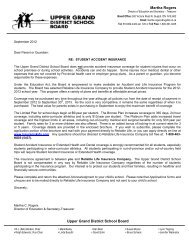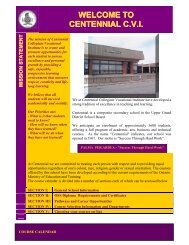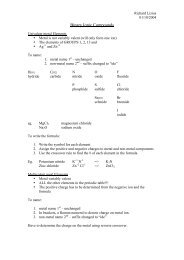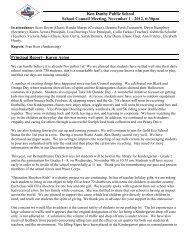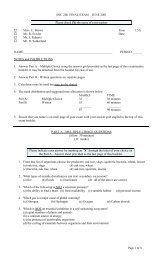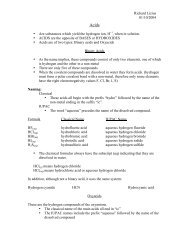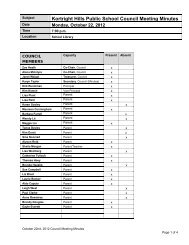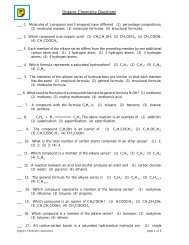Solubility Review
Solubility Review
Solubility Review
Create successful ePaper yourself
Turn your PDF publications into a flip-book with our unique Google optimized e-Paper software.
SCH3U<br />
Some Solution <strong>Review</strong> Questions<br />
1. Sugar is dissolved in water. The sugar and water are respectively the<br />
(a) solvent & solution (b) solute & solvent (c) solution & solute (d) solute & solution<br />
2. All solutions are<br />
(a) heterogeneous (b) cloudy (c) single phased (d) colorless<br />
3. Polar solvents will best dissolve solutes with the greater<br />
(a) London forces (b) hydrogen bonds (c) dipole-dipole force (d) ionic bond<br />
4. Which of the following substances will have the greater solubility in water at room temperature and<br />
pressure?<br />
(a) CH3COOH (b) CH3OH (c) O2 (d) CO2<br />
5. Evaporation of a 23.47 g sample of slush yields a 4.58 g CaCl 2 salt residue. Calculate the W/W<br />
percentage of calcium chloride in the slush.<br />
(a) 5.12% (b) 51.2% (c) 0.195% (d) 19.5%<br />
6. Vinegar is sold as a 5.0% (v/v) solution of acetic acid in water. Assuming that liquid volumes are<br />
additive, what volume of water must be added to 15 mL of acetic acid to produce synthetic vinegar?<br />
(a) 300 mL (b) 290 mL (c) 285 mL (d) 1.00 L<br />
7. The water in a swimming pool is found to have a concentration of 3.0 mg/L of chlorine. This is the<br />
equivalent of<br />
(a) 3.0 ppm (b) 0.3 ppm (c) 0.03 ppm (d) 0.003 ppm<br />
8. Determine the molar concentration when 11.7 g of NaCl are dissolved in water to make 40 mL of<br />
solution.<br />
(a) 0.50 (b) 1.0 (c) 2.0 (d) 5.0<br />
9. A 0.2 M solution of HCl is prepared. The volume of a 300 mL sample is reduced to 60 mL through<br />
evaporation. The final concentration is<br />
(a) 0.2 (b) 0.4 (c) 0.8 (d) 1.0<br />
10. A clear solution is made from 1.5 L of 0.40 M MgCl2 and 0.50 L of water. The resultant<br />
concentration of chloride ion is<br />
(a) 0.60 M (b) 0.57 M (c) 0.45 M (d) 0.37 M<br />
11. A crystal of sodium chloride is dropped into a beaker containing a saturated solution of sodium<br />
chloride and some undissolved sodium chloride on the bottom of the beaker. What will be observed?<br />
(a) the undissolved excess will dissolve (b) the added crystal will grow<br />
(c) no observeable change will occur (d) the added crystal will dissolve<br />
12. A saturated solution of KNO3 may be made unsaturated by<br />
(a) raising the temperature<br />
(b) raising the pressure<br />
(c) adding a crystal of potassium nitrate (d) evaporating some of the water
13. For which of the following, can the metal ions be separated from one another by adding a solution of<br />
sodium hydroxide?<br />
(a) cobalt nitrate and aluminum nitrate (b) barium nitrate and potassium chlorate<br />
(c) magnesium nitrate and nickel nitrate (d) potassium nitrate and iron(II) nitrate<br />
14. Which of the following best represents the net ionic equation for the reaction between FeCl3 and<br />
NaOH?<br />
(a) Fe +3<br />
(aq) + 3 OH-1 (aq) Æ Fe(OH) 3(s)<br />
(b) Fe +3<br />
(aq) + 3 Cl-1 (aq) + 3 Na+ (aq) + 3 OH-1 (aq) Æ Fe(OH) 3(aq) + 3 NaCl(s)<br />
(c) Fe +3<br />
(aq) + 3 Cl-1 (aq) + 3 Na+ (aq) + 3 OH-1 (aq) Æ Fe(OH) 3(s) + 3 NaCl(aq)<br />
(d) Fe +3<br />
(aq) + 3 Cl-1 (aq) + 3 NaOH (aq) Æ Fe(OH)3(s) + 3 NaCl(aq)<br />
15. Chemically, soap is a<br />
(a) a fat or oil (b) fatty acid (c) sodium salt of fatty acid (d) a mixture of glycerine and fat<br />
16. "Temporarily" hard water may contain<br />
(a) MgCl 2 (b) CaCO 3 (c) CaSO 4 (d) Ca(HCO 3 ) 2<br />
17. Bubbles rise in a newly opened bottle of a carbonated beverage. This action is explained by the fact<br />
that carbon dioxide is less soluble in water when<br />
(a) pressure is increased.<br />
(b) pressure is reduced.<br />
(c) temperature is increased.<br />
(d) temperature is reduced.<br />
18. Which solution contains the greatest mass of solute in 100 g of water?<br />
(a) A saturated solution of NaCl at 100 °C<br />
(b) A saturated solution of KCl at 50 °C<br />
(c) A saturated solution of NaNO 3 at 25 °C<br />
(d) A saturated solution of KNO 3 at 25 °C<br />
(e) A saturated solution of K 2 CrO 4 at 50 °C<br />
19. Which of the following compounds would be most highly dissociated or ionized in water at room<br />
temperature and pressure<br />
(a) ammonia (b) acetic acid (c) hydrochloric acid (d) methyl alcohol<br />
20. A solution which contains an equal number of hydrogen ions and hydroxide ions is<br />
(a) an acidic solution (b) a basic solution (c) a neutral solution (d) a solid solution<br />
21. The species responsible for the acidic properties of any aqueous acid is<br />
(a) the hydroxide ion (b) the hydrogen ion (c) the negative ion (d) the oxide ion
22. Which of the following could be used to determine whether or not an acid is strong or weak?<br />
(a) effect on litmus paper<br />
(b) measurement of solubility<br />
(c) determination of concentration<br />
(d) measurement of electrical conductivity<br />
23. Which of the following statements concerning acids and bases is true?<br />
(a) All acids are strong electrolytes.<br />
(b) All bases are strong electrolytes.<br />
(c) All acid solutions with a concentration of greater than 1mol/L are strong acids.<br />
(d) The strongest acids are those which ionize to the greatest extent when dissolved in water.<br />
(e) Water can act as either an acid or a base, and is thus one of the strongest electrolytes of all.<br />
24. An acidic solution, such as vinegar,<br />
(a) turns litmus paper blue (b) has a salty taste (c) has a sour taste (d) feels slippery<br />
25. If the concentration of acid in a solution is decreased, the<br />
(a) [H + ] increases and pH decreases (b) [H + ] decreases and pH increases<br />
(c) [H + ] and pH both increase<br />
(d) [H + ] and pH both decrease<br />
26. What is the concentration of H3O + in a solution whose pH is 4?<br />
(a) 10 4 M (b) 10 -4 M (c) 10 -10 M (d) 4 M<br />
27. The pH of a 0.001 M solution of HCl is<br />
(a) 1 (b) 2 (c) 3 (d) 4<br />
28. What is the hydrogen ion concentration, [H + ], of a 0.001 M solution of sodium hydroxide, NaOH?<br />
(a) 1 ¥ 10 –3 M (b) 1 ¥ 10 –9 M (c) 1 ¥ 10 –11 M (d) 1 ¥ 10 –14 M<br />
29. According to the Arrhenius definition, one product formed when an acid reacts with a base is<br />
(a) a salt (b) an oxide (c) a hydride (d) an anhydride<br />
30. What role does the water play in this reaction?<br />
HCl(g) + H 2 O(l) Æ H 3 O + (aq) + Cl – (aq)<br />
(a) proton acceptor (b) electron acceptor (c) proton donor (d) elector donor<br />
31. What is the conjugate base of the acid H 3 PO 4 ?<br />
H 3 PO 4 (aq) + H 2 O(l) Æ H 3 O + (aq) + H 2 PO – 4 (aq)<br />
(a) H 3 O + (aq) (b) H 2 O(l) (c) H 2 PO – 4 (aq) (d) OH – (aq)<br />
32. In the reaction:<br />
NH 3 (aq) + H 2 O(l) Æ NH + 4 (aq) + OH – (aq)<br />
which is a conjugate acid–base pair?<br />
(a) NH 4+ , H 2 O (b) NH 4+ , NH 3 (c) H 2 O, NH 3 (d) OH – , NH 3<br />
33. How does the pH of the mixture change as hydrochloric acid, HCl, is slowly added to a solution of<br />
sodium hydroxide, NaOH?<br />
(a) The pH decreases and may go below 7 (b) The pH increases and may go above 7<br />
(c) The pH decreases to 7 and stops (d) The pH increases to 7 and stops
34. How many grams of beryllium chloride are needed to make 125 mL of a 0.050 M solution?<br />
35. The density of ethanol is 0.789 g/mL. How many grams of ethanol should be mixed with 225 mL of<br />
water to make a 4.50% (v/v) mixture?<br />
36. To what volume will you have to dilute 30.0 mL of a 12 M HCl solution to make a 0.35 M HCl<br />
solution?<br />
37. Indicate the solvent that will be best at dissolving the given solute in each of the following problems:<br />
Solute: LiC 2 H 3 O 2 Solvents: CS 2 or CH 2 Cl 2<br />
Solute: PI 3<br />
Solvents: NH 3 or H 2 O<br />
38. An acidic solution has a pH of 4.00. If I dilute 10.00 mL of this solution to a final volume of 1000.00<br />
mL, what is the pH of the resulting solution?<br />
39. What is the pH of a solution that contains 1.20 moles of nitric acid (HNO 3 ) and 1.70 moles of<br />
hydrochloric acid (HCl) dissolved in 1000.0 liters of water?<br />
40. If it takes 50.0 mL of 0.50 M KOH solution to completely neutralize 125 mL of sulfuric acid solution<br />
(H 2 SO 4 ), what is the concentration of the H 2 SO 4 solution?<br />
41. If it takes 25 mL of 0.050 M HCl to neutralize 345 mL of NaOH solution, what is the concentration of<br />
the NaOH solution?<br />
42. Using your knowledge of the Brønsted-Lowry theory of acids and bases, write equations for the<br />
following acid-base reactions and indicate each conjugate acid-base pair:<br />
a) HNO 3 + OH - ‡<br />
b) CH 3 NH 2 + H 2 O ‡<br />
c) OH - + HPO -2 4 ‡<br />
43. If the titration curve below is for the titration of 5.0 mL of hydrochloric acid using aluminum<br />
hydroxide, calculate the concentration of the aluminum hydroxide solution.<br />
14<br />
12<br />
10<br />
pH<br />
8<br />
6<br />
4<br />
2<br />
0<br />
0 5 10 15 20 25 30 35 40<br />
Volume of Base Added (mL)




